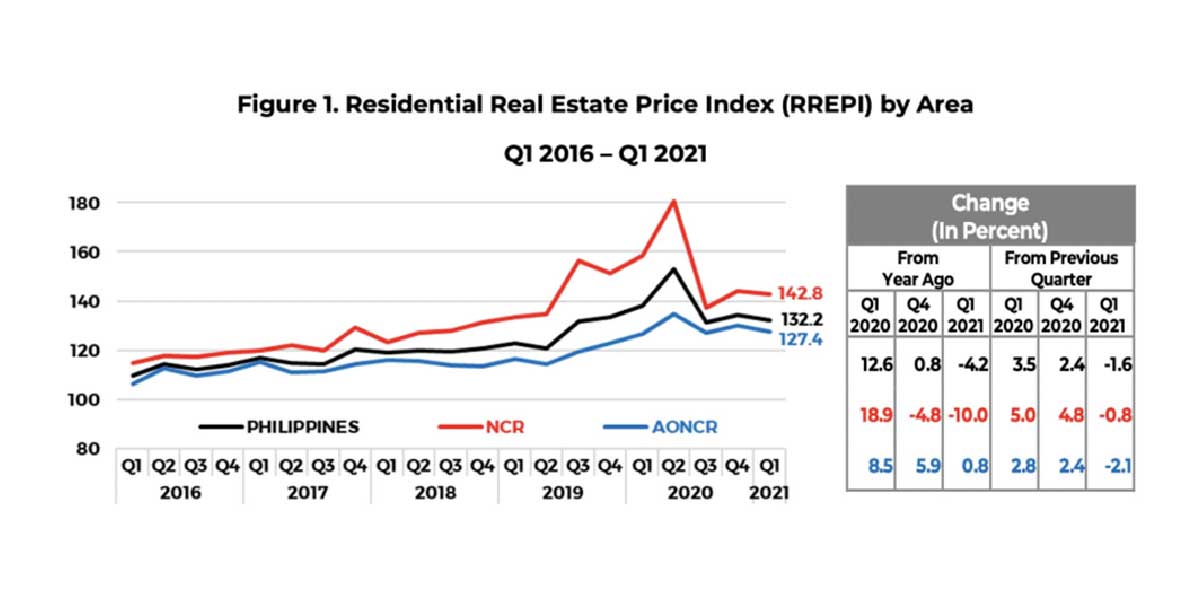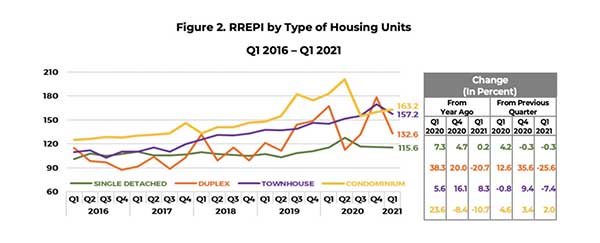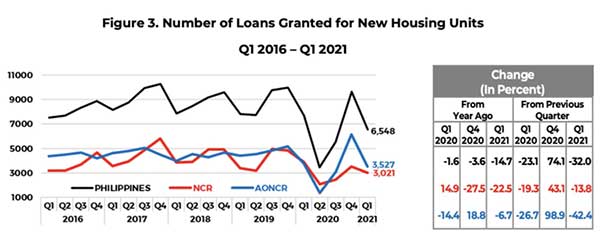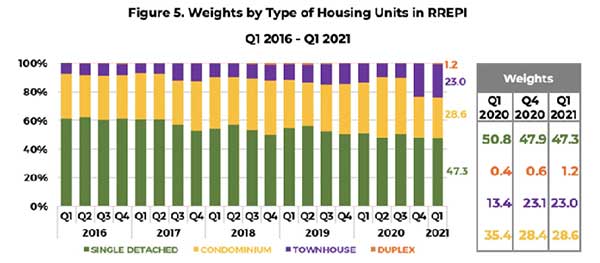Nationwide residential property prices fell by 4.2% YoY in Q1 2021
Following a slight uptick in the previous quarter, residential real estate prices of various types of new housing units in the Philippines declined in Q1 2021 based on the Residential Real Estate Price Index (RREPI). Nationwide house prices contracted by 4.2 percent year-on-year (YoY) and by 1.6 percent quarter-on-quarter (QoQ) due to the subdued demand for residential properties amid the pandemic (Figure 1).1

By area, residential property prices decrease YoY in NCR, but increase in Areas Outside NCR (AONCR)
The negative YoY growth in nationwide residential property prices was driven mainly by the downtrend of property prices in the NCR, which fell by 10 percent relative to Q1 2020, marking three consecutive quarters of declines since Q3 2020 (Figure 1). This was due to the decrease in the prices of condominium units, which outweighed the increase in the prices of duplexes, single detached/attached houses, and townhouses. Meanwhile, property prices in AONCR rose marginally by 0.8 percent YoY as the growth in the prices of townhouses and condominium units more than offset the drop in the prices of duplexes and single detached/attached houses. On a QoQ basis, house prices contracted in the NCR (by 0.8%) and AONCR (by 2.1%), following the national trend.
By type of housing units, the change in residential property prices is mixed
Prices of duplexes and condominium units declined YoY in Q1 2021 by 20.7 percent and 10.7 percent, respectively, while prices of townhouses and single detached/attached houses increased by 8.3 percent and 0.2 percent, respectively. This is the third consecutive quarter that condominium prices declined, owing to the lackluster demand for condominiums in NCR. The 4.2 percent YoY drop in the RREPI was primarily driven by the fall in prices of condominium units and duplexes. Meanwhile, the QoQ contraction of 1.6 percent in the RREPI was attributed to the lower prices of duplexes, townhouses, and single detached/attached houses, which more than offset the higher prices of condominium units (Figure 2).

Residential real estate loans for new housing units dip YoY and QoQ
In Q1 2021, the number of RRELs granted for all types of new housing units in the Philippines contracted by 14.7 percent YoY and 32 percent QoQ. A similar trend was observed in NCR and AONCR (Figure 3).

The average appraised value per sqm of new housing units in the country contracted by 13.6 percent YoY but expanded by 12.5 percent QoQ. In both NCR and AONCR, the average appraised value per sqm of new properties was lower YoY, but higher QoQ (Figure 4). By type of new dwellings, duplexes and condominium units registered YoY decline in average appraised values per sqm while single detached/attached houses, duplexes, and townhouses posted QoQ drop in average appraised values.

The weight of each type of housing unit in the RREPI is determined by dividing the total floor area (in sqm) of a specific type of housing unit over the total floor area of all housing types. Hence, in Q1 2021, single detached/attached houses in the RREPI continued to constitute the largest weight at 47.3 percent. Meanwhile, condominium units, townhouses, and duplexes accounted for 28.6 percent, 23 percent and 1.2 percent, respectively (Figure 5).

Profile of residential real estate loans in Q1 2021
In Q1 2021, the purchase of new housing units accounted for 79.5 percent of residential real estate loans (RRELs). Meanwhile, by type of housing unit, most of the residential property loans were used for the acquisition of condominium units (52 percent), followed by single detached/attached houses (38.6 percent) and townhouses (8.1 percent) as seen in Figure 6.
Most of the RRELs granted in NCR were for the purchase of condominium units, while RRELs granted in AONCR were for the purchase of single detached/attached houses. By region, 48.4 percent of the total number of RRELs granted were from the NCR, while the rest were distributed in AONCR―CALABARZON (25.4 percent), Central Luzon (9.6 percent), Central Visayas (5.4 percent), Western Visayas (3.7 percent), Davao Region (3 percent), and Northern Mindanao (1.3 percent). NCR and the said six regions combined accounted for 96.8 percent of total housing loans granted by banks (Figure 6).

The RREPI is a measure of the average change in the prices of various types of housing units, i.e., single detached/attached houses, duplexes, townhouses, and condominium units, based on banks’ data on actual loans granted to acquire new housing units only. It is a chain-linked index, which is computed using the average appraised value per square meter, weighted by the share of floor area of each type of housing unit to the total floor area of all housing units. The RREPI is used as an indicator for assessing the real estate and credit market conditions in the country. The BSP has been releasing the report since Q1 2016.
Data for the RREPI are obtained through BSP Circular No. 892 dated 16 November 2015, which requires all universal/ commercial banks (UBs/KBs) and thrift banks (TBs) in the Philippines to submit to the BSP a quarterly report on all RRELs granted.
—————————————————
1 Similarly, it may be noted that the housing rent inflation rate was lower at 1.9 percent YoY, but higher at 0.4 percent QoQ in Q1 2021 from 2.5 percent and 0.2 percent, respectively in Q4 2020. Source: Philippine Statistics Authority (PSA)




















